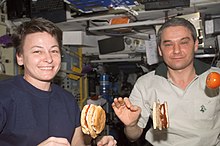Space food
[1] Such food has specific requirements to provide a balanced diet and adequate nutrition for individuals working in space while being easy and safe to store, prepare and consume in the machinery-filled weightless environments of crewed spacecraft.
Coca-Cola has flown on subsequent missions in a specially designed dispenser that utilizes BioServe Space Technologies hardware used for biochemical experiments.
[citation needed] Beer has also been developed that counteracts the reduction of taste and smell reception in space and reduces the possibility of wet burps in microgravity.
Produced by Vostok 4-Pines Stout, a parabolic flight experiment validated that the reduced carbonation recipe met the criteria intended for space.
By 2012 a method was suggested where the dough is leavened by dissolved CO2 (as opposed to yeast) and cooked by a low-temperature process, which could allow for fresh bread to be baked from bulk ingredients on future spaceflights.
[15][16] On Tiangong Space Station, the kitchen is located in the Tianhe core module, along with living quarters and entertainment systems.
"[21][22] Early space food was primarily composed of bite-sized cubes, freeze-dried powders, and thick liquids stuffed in aluminum tubes.
These solutions had their own challenges, however over time, the powders were made easier to re-freeze, and the cubes were coated in gelatin to prevent crumbling on the equipment.
The astronauts found it unappetizing, experienced difficulties in rehydrating the freeze-dried foods, and did not like having to squeeze tubes or collect crumbs.
Tubes (often heavier than the foods they contained) were abandoned, gelatin coatings were added to the bite-sized cubes to help prevent them from crumbling, and simpler rehydration methods were developed.
The menus were also expanded to include items such as shrimp cocktail, chicken and vegetables, toast squares, butterscotch pudding, and apple juice.
Mission Commander Gus Grissom loved corned beef sandwiches, so Pilot John Young brought one along, having been encouraged by fellow astronaut Walter Schirra.
Floating crumbs from the bread posed a potential problem, causing Grissom to put the sandwich away and the astronauts were mildly rebuked by NASA for the act.
[30][31][32] Prior to the Apollo program (1968–1975), early space food development was conducted at the United States Air Force School of Aerospace Medicine and the Natick Army Labs.
Appetizing foods would increase the crew's chances of maintaining proper nutrition,[23] and the "spoon-bowl" allowed more normal eating practices.
Thus, the astronauts were always looking for something that had a little more taste; Apollo 17 moonwalker Harrison Schmitt's favorite food was the bacon squares, while Buzz Aldrin enjoyed the shrimp and Paul J. Weitz went for the ice cream.
The Orbital Work Shop (OWS) module had a specially designed wardroom dedicated for food preparation and dining (see image on the right).
[citation needed] A dining table was also available, and was designed to avoid hierarchical positions through its triangular layout and to support social cohesion.
Shrimp cocktail and butter cookies were consistent favorites; Lobster Newberg, fresh bread,[40] processed meat products, and ice cream were among other choices.
Among the foods provided by Soyuz 19 were canned beef tongue, packaged Riga bread, tubes of borscht (beet soup), and caviar.
[44][45] The menu includes traditional Bulgarian dishes such as tarator, sarma, musaka, lyutenitza, kiselo mlyako, dried vegetables and fruits, etc.
[49][50] Food on the ISS is similar to the Shuttle, in that it is individually packaged to allow for exchanges and prevent issues in the microgravity environment.
[48] The impact to health can include symptoms such as weight loss, dehydration, a reduction in red blood cell count, constipation and electrolyte imbalances.
[64] At Tiangong space station, meals consisting of 120 different types of food, selected based on astronauts' preferences, are stored aboard.
Huang Weifen, the chief astronaut trainer of CMSA, explains that most of the food is prepared to be solid, boneless, and in small pieces.
[65] Additionally, China's Tiangong-2 station has conducted experiments growing food on board in a micro-gravity environment, such as thale cress, a form of edible weed, as well as rice.
The station also hosts Silkworms - an experiment devised by students to see if they can be used as a source of protein on long-duration space missions.
The primary goal is to provide palatable and nutritious food for astronauts, with the additional consideration of minimising volume, mass and waste.
The importance of biodegradable, edible and reusable packaging solutions have been emphasised, as these will reduce the strain on the solid-waste management system.
[66] A focus is being placed on ensuring astronauts receive not only the recommended levels of nutrients to support mental and physical health, but the correct amounts required for long duration spaceflight.


















